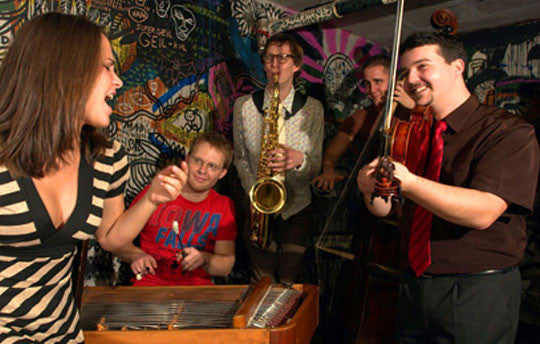Your Cart is Empty

For a country of ten million people, Hungary has a strong musical profile – world-class composers, the extraordinary ‘dancehouse’ phenomenon which finds traditional music flourishing in Budapest and a dynamic Gypsy scene.
 Hungarian music, which bears the influence of folk, gypsy and Jewish tunes, is a living and breathing European tradition with its own unique instruments.
Hungarian music, which bears the influence of folk, gypsy and Jewish tunes, is a living and breathing European tradition with its own unique instruments.
The composers Béla Bartók and Zoltán Kodály were the most influential ethnographers who systematically investigated the peasant music of Hungary. On their collecting trips in the early twentieth century, they revealed the ‘real’ Hungarian folk music – as opposed to the popular salon tunes, and, using the material in their own work they not only found their individual voices but brought the folk music to the attention of an international audience.
Exactly where the Hungarians originated is still debated; but unlike most Europeans, they belong to the Finno-Ugrian linguistic group, whose ancestors lived over 4000 years ago in the Ural region. Kodály found a link between the oldest Hungarian songs, and songs of the Mari people, a Finno-Ugrian group who still live close to the ancestral home in Russia.
Most of the Hungarian music familiar today has its roots in the eighteenth century when the country rebuilt itself as part of the Hapsburg Empire. ‘New style’ music appeared, with a regular metric structure for dancing and marching, while solo bagpipers were replaced by the new Gypsy orchestras, and the medieval-style drone accompaniment gave way to the central European harmony of the string bands.
Gypsies (or more correctly Roma) were first recorded in Hungary in the fourteenth century, and as musicians they became famous from the eighteenth century on. In addition to society gigs, they also performed at recruiting ceremonies where young lads were enticed into the army with verbunkos music. The slow and fast verbunkos dances have been seen as the two contrasting aspects of the Hungarian character and in the nineteenth century, Franz Liszt felt unequivocally that the Gypsies were Hungary’s national musicians and verbunkos was the inspiration for his Hungarian Rhapsodies.
The music of the Roma themselves hardly uses instruments at all. In addition to their urban style music, there’s a contrasting rural variety played by the Vlach (or Olah) Gypsies. This music is traditionally accompanied by rhythmic grunts, the tapping of domestic utensils like spoons and water cans and imitations of instruments in a ‘doobie-doobie-doobie’ sort of way called ‘oral-bassing’. It oscillates between tragic songs about the hardships of Gypsy life and wild, upbeat numbers throwing all cares to the wind.
Parno Graszt (Romani for White Horse) is a real village band from Paszab in northeast Hungary that has made excellent recordings and played a few festivals. Kalyi Jag (Romani for Black Fire) was the first of the Hungarian Roma groups to present their music on stage in 1978. They’ve been followed by bands like Romano Drom and Ando Drom (On the Road), with the extraordinary singer Mitsoura who’s now gone solo.
 Hungarian Gypsy (Roma) music is vibrant, passionate and brimming with colour, yet its songs reflect the hardships of daily life. From the camps and villages of rural Hungary, its popularity has swept around the world. The Rough Guide To The Music Of Hungarian Gypsies explores the Gypsy revival with leading artists including Ando Drom, Kalyi Jag, Romano Drom, and Parno Graszt.
Hungarian Gypsy (Roma) music is vibrant, passionate and brimming with colour, yet its songs reflect the hardships of daily life. From the camps and villages of rural Hungary, its popularity has swept around the world. The Rough Guide To The Music Of Hungarian Gypsies explores the Gypsy revival with leading artists including Ando Drom, Kalyi Jag, Romano Drom, and Parno Graszt.
The Hungarian capital is one of the best places in Europe to hear really good folk music, and the place to go is a táncház – literally a ‘dance house.’ The táncház movement started in the 1970s, when musicians like Ferenc Seb? and Béla Halmos followed in the footsteps of Bartók and Kodály, collected music from the villages, and, rather than presenting it on stage, brought it back to the grassroots in Budapest. The most popular kind of táncház music comes directly from the village tradition and that means Transylvania. The csárdás is the most famous Hungarian dance tune and you won’t spend five minutes at a Budapest táncház without hearing one.
Internationally, the best-known names in Hungarian music emerged from this scene: Márta Sebestyén, a truly remarkable singer and Muzsikás, one of the first of the dancehouse groups. Other top musicians include fiddler Csaba Ökrös and the Tükrös, Téka and Kalamajka groups, singers Kati Szvorák, Beáta Palya, Irén Lovász and András Berecz. Clarinettist and saxophonist Mihály Dresch pursues a much more experimental line, and the young virtuoso violinist Félix Lajkó plays rhythmic and infectious concert music.